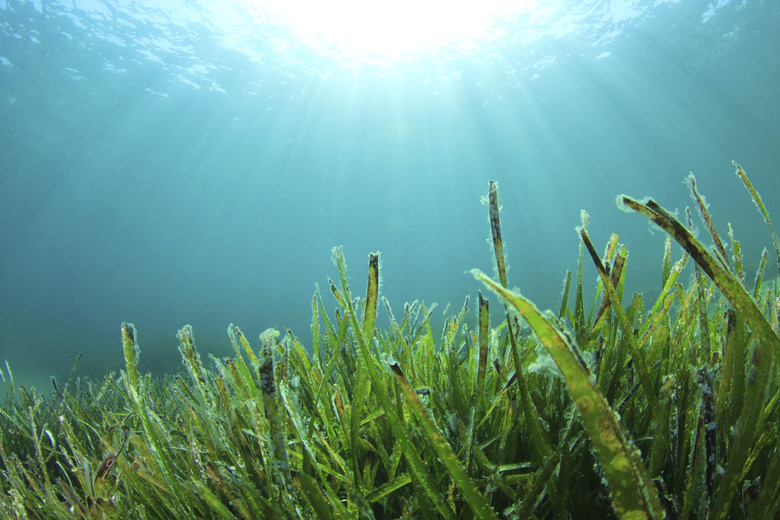What Organisms Eat Seaweed?
Many sea animals eat algae around the globe, from small crustaceans, including bristle worms (Polychaeta) and snails (Gastropoda), to large mammals such as manatees (Trichechus spp.). Seaweed is a valuable food source for sea animals that eat algae – full of minerals, vitamins, fiber and protein with essential amino acids.
Types of Seaweed
Types of Seaweed
In the scientific world, seaweed is referred to as benthic macroalgae, which means it is a type of algae visible to the naked eye that tends to secure itself to the seabed. Macroalgae is further classified into three groups: green algae (Chlorophyta), brown algae (Phaeophyceae) and red algae (Rhodophyta). These types of algae come in all different shapes and sizes, from less than an inch to 164 feet long. Globally there are approximately 6,200 species of green algae and 1,800 species each of brown and red algae.
Sea Animals That Eat Algae
Sea Animals That Eat Algae
The ocean is full of sea animals that eat algae, the major photosynthetic primary producer. The types of animals that eat algae in marine environments are primary and secondary consumers. In a basic seaweed food chain, crustaceans eat the seaweed, fish eat the crustaceans and larger fish eat smaller fish, finally leading up to the top-level carnivores such as sharks (Selachimorpha), dolphins (Artiodactyla) and birds like albatross (Diomedeidae). When washed ashore, various types of bacteria and fungi colonize seaweed, feeding on it and breaking it down.
Living Versus Decomposing Seaweed
Living Versus Decomposing Seaweed
To protect themselves from being eaten alive, many seaweeds have chemical defenses. Some organisms, like the isopod Ligia pallasii and amphipod Traskorchestia traskiana prefer eating aged, decomposing algae rather than fresh algae. Once bacterial colonies start to grow on algae, they make it easier to digest. The added bacteria may also increase the nutrient content of this seaweed meal.
Sea Turtles
Sea Turtles
As juveniles, green sea turtles (Chelonia mydas) are mostly carnivorous; however, as they get older, they become one of the larger sea animals that eat algae. Their finely serrated jaws are specially adapted to a vegetarian diet. Green sea turtles use their jaws to rip away chunks of seaweeds and grasses and scrape algae off rocks.
Manatees
Manatees
Manatees are marine mammals that, as adults, weigh between 32 and 108 pounds. Every day they eat the equivalent of 4% to 9% of their body weight in wet vegetation. A manatee's diet consists of various algae, marine grasses, leaves and aquatic plants like water hyacinth (Pontederia crassipes).
Grazing Birds
Grazing Birds
Eating seaweed isn't just confined to aquatic organisms; some terrestrial birds enjoy a seaweed meal too. The brant (Branta bernicla) is a small goose that lives along the coasts of Alaska and Arctic Canada. Brants wait until low tide and then forage for seagrass and seaweeds, ripping them from the ground.
Kelp Forests
Kelp Forests
Many types of brown algae are commonly called kelp. Kelp forests are an important ecosystem in many temperate oceans as they provide a source of food, shelter and breeding grounds for many sea animals. A textbook example of the chain of negative effects within an imbalanced ecosystem is the relationship between kelp forests, sea urchins (Echinoidea), sea stars (Asteroidea) and in some areas, sea otters (Enhydra lutis).
Sea urchins are the primary herbivore in kelp forests, eating their holdfasts. Sea stars and sea otters predate on sea urchins, keeping their population numbers under control. When the sea star or sea otter population levels drop due to exploitation, disease or hunting, sea urchin populations boom, creating "urchin barrens" as the urchins eat entire forests of kelp and prevent more from regrowing. This has drastic effects on the rest of the animals that rely on kelp forests to survive and leads to an overall decline in biodiversity.
References
- National Oceanic and Atmospheric Administration: The Wonderful World of Seaweeds
- SeaWorld Parks & Entertainment: Sea Turtles – Diet & Eating Habits
- Smithsonian Ocean: Stinkin' Seaweed Makes Tasty Food for Coastal Animals
- Science News: How Kelp Forests off California Are Responding to an Urchin Takeover
- OCEANA: Kelp Forest
- Philosophical Transactions of the Royal Society B: Global Regime Shift Dynamics of Catastrophic Sea Urchin Overgrazing
- See Turtles: What Do Sea Turtles Eat?
- Journal of Experimental Marine Biology and Ecology: Degrading Detritus: Changes in Food Quality of Aging Kelp Tissue Varies With Species
- SeaWorld Parks & Entertainment: Manatees – Diet & Eating Habits
Cite This Article
MLA
Jerrett, Adrianne. "What Organisms Eat Seaweed?" sciencing.com, https://www.sciencing.com/organisms-eat-seaweed-8248358/. 30 September 2021.
APA
Jerrett, Adrianne. (2021, September 30). What Organisms Eat Seaweed?. sciencing.com. Retrieved from https://www.sciencing.com/organisms-eat-seaweed-8248358/
Chicago
Jerrett, Adrianne. What Organisms Eat Seaweed? last modified March 24, 2022. https://www.sciencing.com/organisms-eat-seaweed-8248358/
